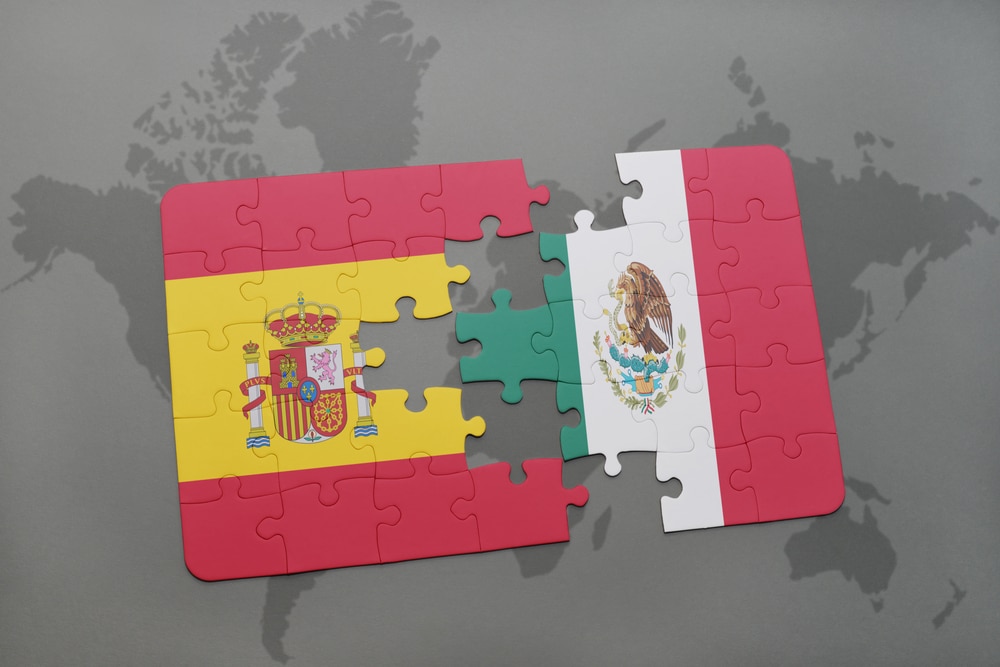Want to learn Spanish before a cultural immersion trip? Relocating for a job and the opportunity to improve your Spanish language skills? Then it’s important you know the differences between European Spanish and Latin American Spanish. From grammar and vocabulary to pronunciation, we’ll show you how Spanish differs from Latin America to Europe.
Why are there different types of Spanish?
Spanish spread across the world thanks to the colonization of the Americas. In this way, Spanish went through a process known as the “colonial lag” But what does it mean?
According to the linguist Albert Mackwardt, the language spoken in colonies does not evolve in the same way as the language in its country of origin. Thus, some words and expressions that have fallen in disuse in the original language may be retained in a colonial variety. In this case, the countries that were colonies of Spain do share some characteristics in their speech. However, they also have distinctive features that originate from their individual culture.
Can speakers of European Spanish and Latin American Spanish understand each other?
Yes. The existence of different types of Spanish doesn’t mean that an Argentinian can’t understand a Colombian. Or that a Spaniard won’t get by in Mexico. Just like an Australian can understand a British and an American, Spanish speakers understand each other just as well. Nevertheless, you’ll notice a few differences that might help you improve your fluency. Among them are:
The name of the language: Castellano or Español?
In Spain, the Spanish language is called Castilian or ‘castellano’. This refers to the Castile province located in Central Spain, where it is believed the Spanish language originated from. The term is also synonymous with ‘lengua española’.
In contrast, in Latin American countries, Spanish speakers call their language ‘español’. Easy!
Pronunciation
The most noticeable pronunciation differences between the Spanish of Spain and the Spanish of Latin America are:
- The use of the Spanish “theta”
- The variations of the “ll” sound around the world
- The regional accents
- The drop of some final sounds
The Spanish “Theta”
Symbolized as /θ/, its name in Phonetics is voiceless dental fricative, /θ/. And it’s the sound that replaces the English “th” in thanks and bath.
Castilian Spanish has a particular way to pronounce the letter Z before any vowel, which sounds almost like a lisp. Additionally, Spaniards use /θ/ to pronounce the letter C before I and E.
On the other hand, in Latin American Spanish, Z and C before I and E always sound like an S. Yes, the S of “Simon”. The origin of this difference is presumed to be that most Spanish sailors that went to the colonies were from the region of Andalucía. In this part of Spain, people pronounce Z closer to an S than to theta, which was mimicked by the indigenous people in the colonies.
Thus, zapato is pronounced [θaˈpato] in Spain (except in South Spain) and [saˈpato] in Latin America. Spaniards pronounce cielo as [‘θjelo] and Latin Americans as [‘sjelo].
The “LL” sound around the world
The easiest to learn for English speakers. Yeísmo is pronouncing LL just like a Y sound. Yeísmo gained notoriety in Spanish between the centuries XIV and XVI. While it used to be seen as an uneducated pronunciation in the XX century, but nowadays, it’s the panhispanic norm. Thus, the yeísmo is commonly widespread among Spanish speakers. Bolivia, Paraguay, Peru, Colombia, Venezuela, and Ecuador are some examples of the long list of countries that practice yeísmo.
For example, Latin Americans say “Yo digo que vayamos” and pronounce it JO-DEE-GOH-KEH-BAYAMOS).
- LL as a J
If you say words like ‘jump’, ‘magic’, or ‘reject’, you’ll recognize that you are, essentially, pronouncing a soft J between your front teeth. This sound of LL isn’t exclusive to one country or region of the world. You can find it in many Spanish-speaking countries that make a distinction between Ll and J. In Latin America, countries that pronounce LL as the J in “blue jeans” are Bolivia, Paraguay, Peru, Ecuador, and Colombia. In Spain, people from the regions of Castilla y León, Cataluña, Valencia, Navarra, País Vasco, Aragón, Murcia y Extremadura do it as well.
- LL as SH
The sound you make to silence people around you is limited almost exclusively to the South of South America. Specifically, to Uruguay and Argentina. So, if you’re visiting La Pampa, you’ll hear words like llama and caballo pronounced as SHama and cabaSHo. This particular way to pronounce LL is called yeísmo rehilado, which comes from the influence of the languages of the immigrants that went to Argentina and Uruguay in the XIX and XX century. Those languages were Portuguese, Galician, French, and Italian.
Nevertheless, there is NO need to learn the 3 sounds of LL. Pronounce the one that is easier for you.
How to catch regional accents?
It’s not rare to find that, from place to place, the cadence of speech differs. In other words, people may speak faster than you are used to or intonate words in a peculiar way.
But, don’t worry! Listening to authentic speakers will help you improve your listening skills and, who knows, you might even pick up some new words and the same intonation!
Dropping some final sounds
Another characteristic of the Spanish from Latin America is the drop of the final S in some words. Later, the S becomes slightly aspirated or glottalized.
For example: “Buenos días” actually sounds more like ‘Bueno día’. This is mainly true for countries like Venezuela, Chile, Cuba, Dominican Republic, and Puerto Rico.
Also, in some parts of Spain and countries of the Caribbean people drop the D in the last syllable of a word. Thus, instead of saying “Estoy enamorado” they say “Estoy enamorao”. In the same way, instead of saying “Estoy cansado” they say “Estoy cansao”. You can hear this way of speaking in Caribbean music genre known as reguetón which originated in the 90s in Puerto Rico.
Moreover, speakers from Andalucia Spain, also express themselves dropping the intervocalic Ds and it is believed it came from there. For example, to say “todo” or “nada” they say “tó” and ná. People from Latin America also shorten words with intervocalic D in this way. Therefore, in this sense, we speak the same!
Spanish Vocabulary Differences
Most Spanish words are universal, but some aren’t. Different words may be used for the same objects. You may call an object a certain way but learn a different name for it somewhere else. Other times, terms are interchangeable. Here are some examples:
Pen is bolígrafo, boli, pluma, or lapicero interchangeably.
Peach is melocotón in Spain and durazno in Latin America.
Car is coche in Spain and Mexico, auto in Chile, Argentina, and Uruguay. And in the rest of Latin America, car is carro.
Cell phone is móvil in Spain and celular in Latin America.
And, finally, coger means to grab something in Spain, and… ahem, the act of love in Latin America.
The magic of polisemia -the different meanings a word has- makes this possible, and we could be explaining words here for weeks. However, the ones listed above are some of the most common.
Spanish Grammar Differences
When it comes to grammar, the most common differences are:
- The vosotros, common in Spain.
- The vos, common in Argentina and Uruguay.
- The leismo.
- The past tense
Vosotros vs. Ustedes
When addressing or referring to a group of people (the second person plural) Castilian speakers use vosotros/vosotras. While in Latin America, Spanish speakers use ustedes. Therefore, verbs in Spain have a sixth form of conjugation, instead of five. “How are you?” for an audience of more than one person is ¿Cómo estáis? in Spain and ¿Cómo están? in Latin America.
Vos vs. Tú
The singular second person has a variation in places near the Rio de Plata basin (Argentina, Uruguay, Chile, Bolivia, Paraguay). That is, the use of vos instead of tú, also known as voseo.
In most cases, changing vos for tú doesn’t mean changing the conjugation of the verb. Examples: Tú cenaste becomes Vos cenaste.
Other times, there are some grammar changes:
- For the present tense, the infinitive ending changes, and an accent is added to the final vowel of the verb. Then, AR verbs end in ás, ER verbs end in és, and IR verbs end in ís. For example: Vos no sentís lo mismo que yo.
- For overall Spanish irregular verbs like pedir we change E for I at the ending of words. There is no stem change. Example: vos pedís.
- The voseo, however, does have three irregular verbs unique to it: ser, ir, and haber. Their conjugations are: Tú eres/Vos sos. Tú has/Vos has. Tú vas/Vos vas.
This is valid for places like Argentina, and some parts of Venezuela, Colombia, Panama, Uruguay, Paraguay, Bolivia, Chile, Ecuador, and Mexico.
The leísmo
Castilian Spanish tends to overuse the indirect object pronouns (le, les) when they actually need to use the direct object pronouns (la, lo, los, las). Examples: Le quería mucho (Spain) versus Lo quería mucho (Latin America). So, the leísmo is essentially unique to Spanish from Spain.
The past tense
The way Spanish and Latin Americans talk about the past differs as well. In Spain, it is common to use the present perfect tense to talk about a completed action. In opposition, Latin Americans use the simple past. Examples: He terminado de leer el libro (Spain). Terminé de leer el libro (Latin America). This is very similar to when British use the present perfect and when Americans use the past tense.
What Spanish should you focus on?
You are the only one that has the answer to this question. When choosing what kind of Spanish to learn, first ask yourself… Who will I be working with? Talking to most? Where will I be traveling? What vocabulary, grammar rules, and pronunciation are more comfortable for me? Rest assured, the Spanish you learn will more or less be understood worldwide. At TruFluency you can start your language journey for as little as $35 to meet with your coach, see their style, discuss your goals and see what plan the coach can put together for you. Start your trial now!





